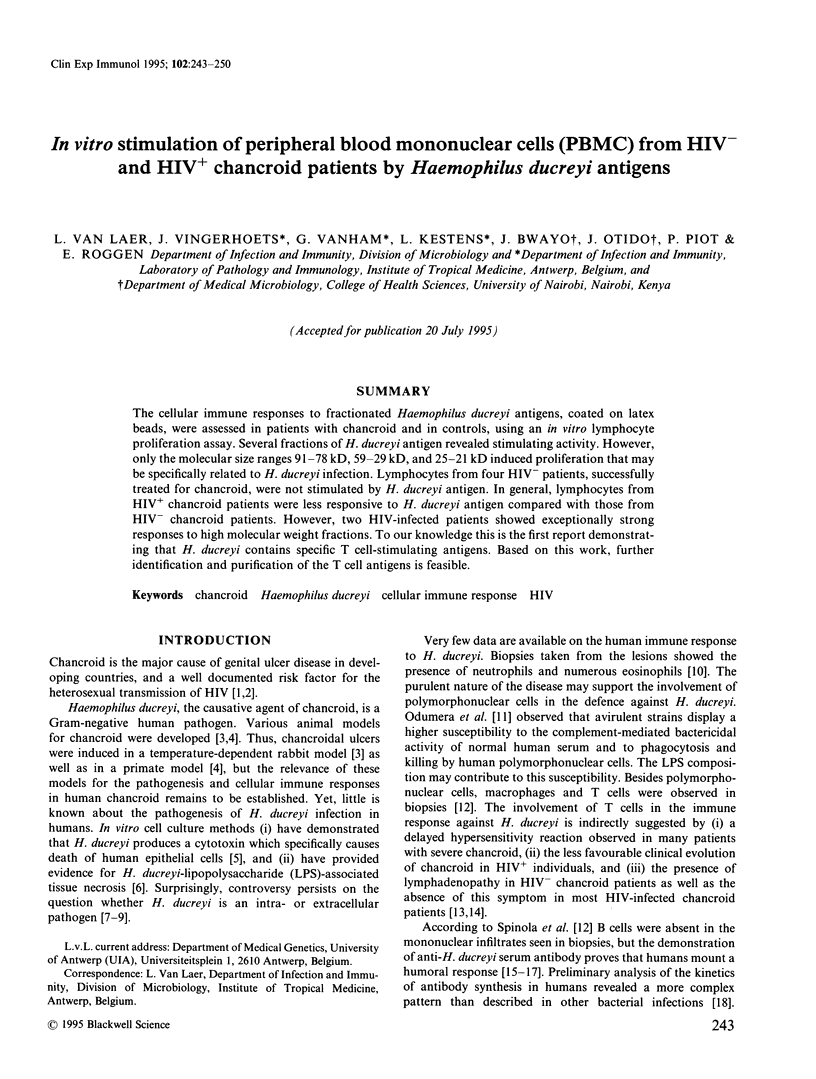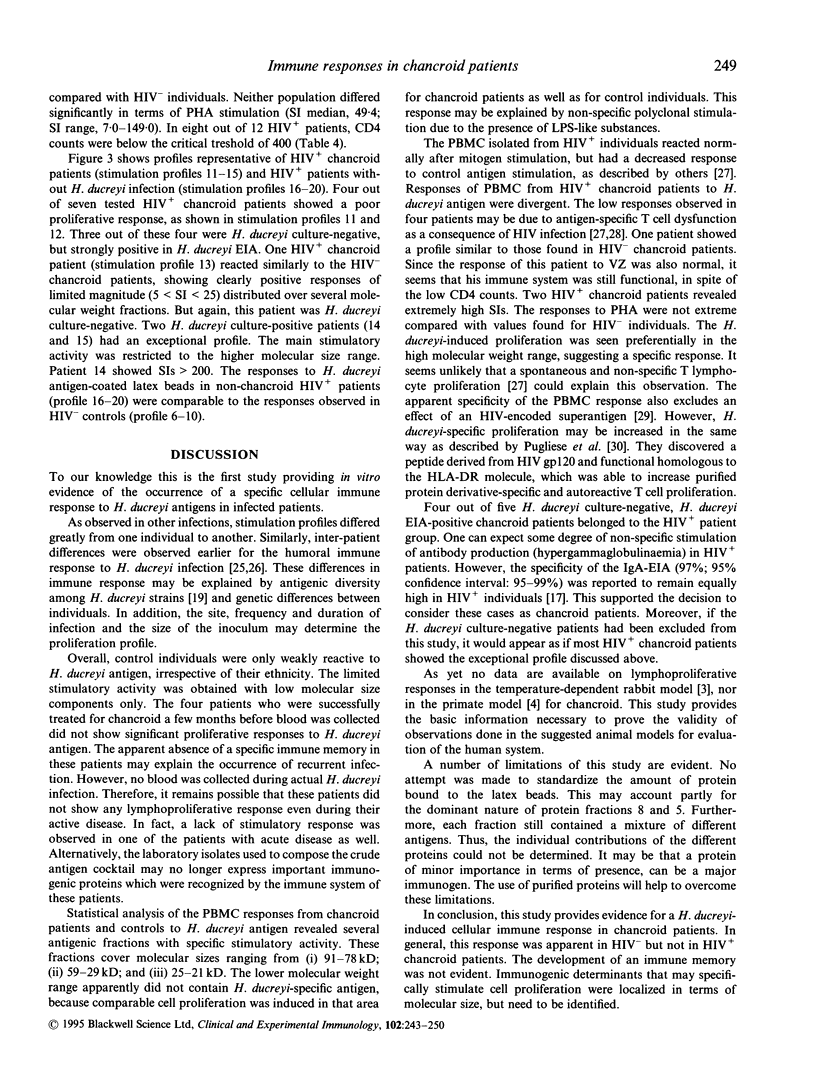Abstract
The cellular immune responses to fractionated Haemophilus ducreyi antigens, coated on latex beads, were assessed in patients with chancroid and in controls, using an in vitro lymphocyte proliferation assay. Several fractions of H. ducreyi antigen revealed stimulating activity. However, only the molecular size ranges 91-78 kD, 59-29 kD, and 25-21 kD induced proliferation that may be specifically related to H. ducreyi infection. Lymphocytes from four HIV- patients, successfully treated for chancroid, were not stimulated by H. ducreyi antigen. In general, lymphocytes from HIV+ chancroid patients were less responsive to H. ducreyi antigen compared with those from HIV- chancroid patients. However, two HIV-infected patients showed exceptionally strong responses to high molecular weight fractions. To our knowledge this is the first report demonstrating that H. ducreyi contains specific T cell-stimulating antigens. Based on this work, further identification and purification of the T cell antigens is feasible.
Full text
PDF







Selected References
These references are in PubMed. This may not be the complete list of references from this article.
- Abeck D., Korting H. C. Mechanisms of skin adherence, penetration and tissue necrosis production by Haemophilus ducreyi, the causative agent of chancroid. Acta Derm Venereol Suppl (Stockh) 1992;174:1–20. [PubMed] [Google Scholar]
- Alfa M. J., Degagne P., Hollyer T. Haemophilus ducreyi adheres to but does not invade cultured human foreskin cells. Infect Immun. 1993 May;61(5):1735–1742. doi: 10.1128/iai.61.5.1735-1742.1993. [DOI] [PMC free article] [PubMed] [Google Scholar]
- Alfa M. J., Olson N., Degagne P., Plummer F., Namaara W., Maclean I., Ronald A. R. Humoral immune response of humans to lipooligosaccharide and outer membrane proteins of Haemophilus ducreyi. J Infect Dis. 1993 May;167(5):1206–1210. doi: 10.1093/infdis/167.5.1206. [DOI] [PubMed] [Google Scholar]
- Desjardins M., Thompson C. E., Filion L. G., Ndinya-Achola J. O., Plummer F. A., Ronald A. R., Piot P., Cameron D. W. Standardization of an enzyme immunoassay for human antibody to Haemophilus ducreyi. J Clin Microbiol. 1992 Aug;30(8):2019–2024. doi: 10.1128/jcm.30.8.2019-2024.1992. [DOI] [PMC free article] [PubMed] [Google Scholar]
- Giorgi J. V., Fahey J. L., Smith D. C., Hultin L. E., Cheng H. L., Mitsuyasu R. T., Detels R. Early effects of HIV on CD4 lymphocytes in vivo. J Immunol. 1987 Jun 1;138(11):3725–3730. [PubMed] [Google Scholar]
- Imberti L., Sottini A., Bettinardi A., Puoti M., Primi D. Selective depletion in HIV infection of T cells that bear specific T cell receptor V beta sequences. Science. 1991 Nov 8;254(5033):860–862. doi: 10.1126/science.1948066. [DOI] [PubMed] [Google Scholar]
- Jessamine P. G., Ronald A. R. Chancroid and the role of genital ulcer disease in the spread of human retroviruses. Med Clin North Am. 1990 Nov;74(6):1417–1431. doi: 10.1016/s0025-7125(16)30488-6. [DOI] [PubMed] [Google Scholar]
- Katrak K., Mahon B. P., Jones W. C., Bräutigam S., Mills K. H. Preparative separation of foreign antigens for highly efficient presentation to T cells in vitro. J Immunol Methods. 1992 Dec 8;156(2):247–254. doi: 10.1016/0022-1759(92)90032-o. [DOI] [PubMed] [Google Scholar]
- Laemmli U. K. Cleavage of structural proteins during the assembly of the head of bacteriophage T4. Nature. 1970 Aug 15;227(5259):680–685. doi: 10.1038/227680a0. [DOI] [PubMed] [Google Scholar]
- Laga M., Nzila N., Goeman J. The interrelationship of sexually transmitted diseases and HIV infection: implications for the control of both epidemics in Africa. AIDS. 1991;5 (Suppl 1):S55–S63. [PubMed] [Google Scholar]
- Lagergård T., Purvén M., Frisk A. Evidence of Haemophilus ducreyi adherence to and cytotoxin destruction of human epithelial cells. Microb Pathog. 1993 Jun;14(6):417–431. doi: 10.1006/mpat.1993.1041. [DOI] [PubMed] [Google Scholar]
- Lammel C. J., Dekker N. P., Palefsky J., Brooks G. F. In vitro model of Haemophilus ducreyi adherence to and entry into eukaryotic cells of genital origin. J Infect Dis. 1993 Mar;167(3):642–650. doi: 10.1093/infdis/167.3.642. [DOI] [PubMed] [Google Scholar]
- Lane H. C., Depper J. M., Greene W. C., Whalen G., Waldmann T. A., Fauci A. S. Qualitative analysis of immune function in patients with the acquired immunodeficiency syndrome. Evidence for a selective defect in soluble antigen recognition. N Engl J Med. 1985 Jul 11;313(2):79–84. doi: 10.1056/NEJM198507113130204. [DOI] [PubMed] [Google Scholar]
- Lee C., Levin A., Branton D. Copper staining: a five-minute protein stain for sodium dodecyl sulfate-polyacrylamide gels. Anal Biochem. 1987 Nov 1;166(2):308–312. doi: 10.1016/0003-2697(87)90579-3. [DOI] [PubMed] [Google Scholar]
- MacDonald K. S., Cameron D. W., D'Costa L., Ndinya-Achola J. O., Plummer F. A., Ronald A. R. Evaluation of fleroxacin (RO 23-6240) as single-oral-dose therapy of culture-proven chancroid in Nairobi, Kenya. Antimicrob Agents Chemother. 1989 May;33(5):612–614. doi: 10.1128/aac.33.5.612. [DOI] [PMC free article] [PubMed] [Google Scholar]
- Morse S. A. Chancroid and Haemophilus ducreyi. Clin Microbiol Rev. 1989 Apr;2(2):137–157. doi: 10.1128/cmr.2.2.137. [DOI] [PMC free article] [PubMed] [Google Scholar]
- Odumeru J. A., Wiseman G. M., Ronald A. R. Virulence factors of Haemophilus ducreyi. Infect Immun. 1984 Feb;43(2):607–611. doi: 10.1128/iai.43.2.607-611.1984. [DOI] [PMC free article] [PubMed] [Google Scholar]
- Ortíz-Zepeda C., Hernández-Pérez E., Marroquín-Burgos R. Gross and microscopic features in chancroid: a study in 200 new culture-proven cases in San Salvador. Sex Transm Dis. 1994 Mar-Apr;21(2):112–117. doi: 10.1097/00007435-199403000-00011. [DOI] [PubMed] [Google Scholar]
- Pugliese O., Viora M., Camponeschi B., Cordiali Fei P., Caprilli F., Chersi A., Evangelista M., Di Massimo A. M., Colizzi V. A gp120 HIV peptide with high similarity to HLA class II beta chains enhances PPD-specific and autoreactive T cell activation. Clin Exp Immunol. 1992 Nov;90(2):170–174. doi: 10.1111/j.1365-2249.1992.tb07923.x. [DOI] [PMC free article] [PubMed] [Google Scholar]
- Purcell B. K., Richardson J. A., Radolf J. D., Hansen E. J. A temperature-dependent rabbit model for production of dermal lesions by Haemophilus ducreyi. J Infect Dis. 1991 Aug;164(2):359–367. doi: 10.1093/infdis/164.2.359. [DOI] [PubMed] [Google Scholar]
- Purvén M., Lagergård T. Haemophilus ducreyi, a cytotoxin-producing bacterium. Infect Immun. 1992 Mar;60(3):1156–1162. doi: 10.1128/iai.60.3.1156-1162.1992. [DOI] [PMC free article] [PubMed] [Google Scholar]
- Roggen E. L., De Breucker S., van Dyck E., Piot P. Antigenic diversity in Haemophilus ducreyi as shown by western blot (immunoblot) analysis. Infect Immun. 1992 Feb;60(2):590–595. doi: 10.1128/iai.60.2.590-595.1992. [DOI] [PMC free article] [PubMed] [Google Scholar]
- Roggen E. L., Hoofd G., Van Dyck E., Piot P. Enzyme immunoassays (EIAs) for the detection of anti-Haemophilus ducreyi serum IgA, IgG, and IgM antibodies. Sex Transm Dis. 1994 Jan-Feb;21(1):36–42. doi: 10.1097/00007435-199401000-00008. [DOI] [PubMed] [Google Scholar]
- Totten P. A., Morton W. R., Knitter G. H., Clark A. M., Kiviat N. B., Stamm W. E. A primate model for chancroid. J Infect Dis. 1994 Jun;169(6):1284–1290. doi: 10.1093/infdis/169.6.1284. [DOI] [PubMed] [Google Scholar]
- Vingerhoets J., Vanham G., Kestens L., Gigase P. A convenient and economical freezing procedure for mononuclear cells. Cryobiology. 1995 Feb;32(1):105–108. doi: 10.1006/cryo.1995.1009. [DOI] [PubMed] [Google Scholar]


